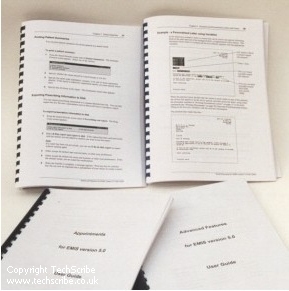User guides
 A user guide is task-based documentation. A user guide is document that explains how to use software to do procedures. A user guide answers the question, "How do I…?"
A user guide is task-based documentation. A user guide is document that explains how to use software to do procedures. A user guide answers the question, "How do I…?"
A user guide can contain operating instructions, maintenance instructions, technical descriptions, flow charts, drawings, and diagrams.
Sometimes, a user guide has full information about all the tasks that users do. Sometimes, a user guide has information only about the most frequent tasks or the most important tasks that users do.
Usually, a good combination of documentation is a user guide that contains only basic information, and online documentation that has full help about a product. This combination of documents has these benefits:
- Users have all the necessary information.
- The user guide is comparatively small.
- Software developers can write the reference information in online documentation.
What is a good user guide?
A good user guide has these benefits:
- Increase your customers' opinions of your software
- Increase your software sales
- Decrease your service desk costs.
What is a good user guide? Anyone can write, "Enter your name in the Name field and click Continue to continue." However, that type of documentation is useless.
A good user guide helps people to use software. To explain things that are clear is not necessary. However, what is 'clear' is dependent on the knowledge of the people who use the software. TechScribe supplies documentation for the difficult problems. If software is simple, then detailed explanations are not necessary. Sometimes, software is difficult to use for these reasons:
- The subject is complex.
- The procedures that people do are complex.
- Complex connections exist between different software modules.
The largest problem with bad user guides is that they do not answer users' questions. To make sure that the user guide is effective, we learn about your software and we ask you many questions. After we understand your software, we can design and develop an effective user guide.